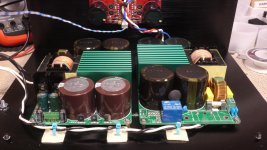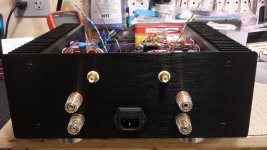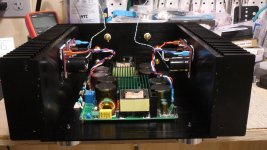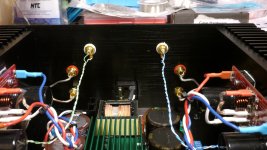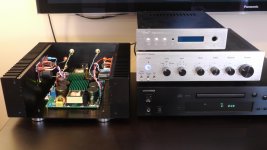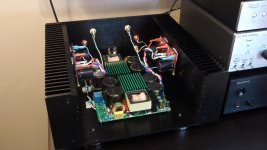Yes, also very ecological one, not to mention a historic value of some vintage gear lying around not in use. First One modules were designed so small and compact having especially those restoration cases in mind. What gives more pleasure in DIY to build something by yourself and by doing it also to revive some beasts to shine again. There's also very cheap buy of broken amps from local service guy, both of you would be happy, win-win. Just happened to know the guy whos installing First One with SMPS in a vintage power amp MA5002. 😉Extremely good idea.
And probably very much cheaper than ordering new chassis, terminals etc.
Thanks Everyone!
You all have provided very valuable insights to heatsinking. This is the first time I have really dug into this topic, so I am learning a lot. I am thinking a lot of the consumer amps I have owned in the past were significantly undersinked. 😱 I am thinking, I may even get better performance out of my LM3875 amps. They have not overheated or shut down, but they lose some of their "smoothness" at higher levels. This could simply be me over working them too. 😀
From what I have read, this would work IF one gets the thermal paste right between the layers. As I understand it, the thermal paste between pieces of metal does not transfer heat as well if the same pieces where a solid piece of metal.
I had a feeling I was off a bit. 😱 I prefer to have it wrong now, before I have spent the money...
I have noticed that even though the 2U 300 mm Dissipante chassis indeed SHOULD be enough, I have noticed that most people have followed Lazy's lead and went with heatsinks rated for 0,4 C/W.
 Nice builds, guys. It is nice when people post pictures of their builds.
Nice builds, guys. It is nice when people post pictures of their builds.
So in the case of the 2U 400 mm Chassis, each mosfet would be on its own 200 mm heatsink rated at 0,68 C/W. Question is, would that give us the 45 deg C idle temp we are after, given the mosfets are not mounted in the ideal location (the middle) of each heatsink?
Hence very interest in this module, plus it has the AB power for the dynamics also. 😀
Therefore, is that the reason everyone is going for the 0.4 C/W, to keep the Amp versatile for future speaker builds? I am sure there is a point, say at 0.35 C/W where one could go too far, lower the idle temp of the amp, therefore losing the benefit of the "electronic sweet spot?"
I know what I really want, but I can not source the parts. 😛
What is tough, is we have limited choices here in the US with heatsinks at these ratings. Surprising really. So these are the choices I am considering now:
The Dissipante 2U 300 mm should work, esp with 8 ohm speakers
The Dissipante 2U 400 mm should be perfect, pending the feedback per questions above...
The Dissipante 3U 300 mm is a sure winner - similar to fluid's and danny_66's builds above.
And I have one more source to try for the SK 157, located in Canada. Maybe they are willing to deal with the "small" sales. 😛
Again, Thanks to everyone for digging into this with me, I am sure it will help others who are building and choosing chassis for their builds. 😉
You all have provided very valuable insights to heatsinking. This is the first time I have really dug into this topic, so I am learning a lot. I am thinking a lot of the consumer amps I have owned in the past were significantly undersinked. 😱 I am thinking, I may even get better performance out of my LM3875 amps. They have not overheated or shut down, but they lose some of their "smoothness" at higher levels. This could simply be me over working them too. 😀
Surface area is your friend much more than mass. If you want to spread the heat out over a larger surface area use a copper sub plate between the output devices and the aluminum heat sink, that will spread the heat faster over a wider area and make it more effective.
From what I have read, this would work IF one gets the thermal paste right between the layers. As I understand it, the thermal paste between pieces of metal does not transfer heat as well if the same pieces where a solid piece of metal.
There are a couple of things that I don't think you have got right and they are causing you some headaches!
I had a feeling I was off a bit. 😱 I prefer to have it wrong now, before I have spent the money...
The 0.45C/W of the 2U modushop chassis is actually very close to ideal.
I have noticed that even though the 2U 300 mm Dissipante chassis indeed SHOULD be enough, I have noticed that most people have followed Lazy's lead and went with heatsinks rated for 0,4 C/W.
Adding two 0.28C/W modules together doesn't give a single 0.14C/W heatsink but it does give you 2 x 0.28C/W heatsinks if this makes sense
Also the FirstOne module is placed in the middle of the heatsinks, so each heatsink has one mosfet.
 Nice builds, guys. It is nice when people post pictures of their builds.
Nice builds, guys. It is nice when people post pictures of their builds.So in the case of the 2U 400 mm Chassis, each mosfet would be on its own 200 mm heatsink rated at 0,68 C/W. Question is, would that give us the 45 deg C idle temp we are after, given the mosfets are not mounted in the ideal location (the middle) of each heatsink?
It' true that modules dissipate quite a lot at idle just to get W or two in Class A, but as we all know first W is very important.
Hence very interest in this module, plus it has the AB power for the dynamics also. 😀
...it's kinda electronic sweet spot. Hard driving 4 Ohm speakers raise the power dissipation greatly so low Rth needed, which is of course in direct relation with heatsink's surface.
Therefore, is that the reason everyone is going for the 0.4 C/W, to keep the Amp versatile for future speaker builds? I am sure there is a point, say at 0.35 C/W where one could go too far, lower the idle temp of the amp, therefore losing the benefit of the "electronic sweet spot?"
I know what I really want, but I can not source the parts. 😛
What is tough, is we have limited choices here in the US with heatsinks at these ratings. Surprising really. So these are the choices I am considering now:
The Dissipante 2U 300 mm should work, esp with 8 ohm speakers
The Dissipante 2U 400 mm should be perfect, pending the feedback per questions above...
The Dissipante 3U 300 mm is a sure winner - similar to fluid's and danny_66's builds above.
And I have one more source to try for the SK 157, located in Canada. Maybe they are willing to deal with the "small" sales. 😛
Again, Thanks to everyone for digging into this with me, I am sure it will help others who are building and choosing chassis for their builds. 😉
Did I mention I couldn't hear any hum with my ear right next to the speaker. Excellent! Personally , I always like to start with a clean slate with my projects. I'm not opposed to re-purposing an old vintage chassis though. My plan with this amp is to install 2 large VU meters on the front panel just for eye-candy. 🙂 But I can't seem to find any large enough that blend nicely with the size of the FP - yet.
This is my first project where the large HSs are getting warm to the touch. Even under very light load. If I played loud and long enough they might get hot! 🙁 I hope these HSs are up to the task. They seem large enough though.
This is my first project where the large HSs are getting warm to the touch. Even under very light load. If I played loud and long enough they might get hot! 🙁 I hope these HSs are up to the task. They seem large enough though.
Rick, that's how it supposed to be. 😉Did I mention I couldn't hear any hum with my ear right next to the speaker. Excellent!
They're just fine, 4 ohm speakers long term fully loaded, heatsinks should be less than 60°C.If I played loud and long enough they might get hot! 🙁 I hope these HSs are up to the task. They seem large enough though.
Well, with properly designed and functioning amps that is. 🙂Rick, that's how it supposed to be. 😉
This amp is Phenomenal!
I put the FO amp into temporary service this morning in my listening room. All I can say is WOW! I thought my last amp (LM4780) added a great sense of dimension, clarity and space to the music. Well, I would be wrong. This amp is absolutely one the best DIY amps I've heard and moves to the top spot so far. I'm warming it up as I write this using my goto all acoustic instruments CD and they sound as if they were all onstage at the end of my room. It's that good. 🙂 The strings are reproduced with fullness and clarity and the highs are effortless and smooth. Vocals are equally clear and simply pour out of the full sound-stage. And there's plenty of solid and faithfully reproduced bass as well. Actually I'm surprised with how solid the punch of bass is when it is called upon to be reproduced. And I don't have a sub-woofer hooked up to this particular rig.
Attached are pics of the wiring I finished up. It's not totally done yet, as the front panel needs a switch and other custom milling for meters. I'm using it with an Onkyo C-7030 CD player, DIY Doug Self 2012 preamp, and Energy, Reference Connoisseur RC-30 speakers. Sounds marvelous. 😀 Even at moderate listening levels the heatsinks are barely warm. A tad warmer around the output devices. Oh, did I say this amp - right out of the box - is super quiet and I simply hear no hum. No tinkering needed here folks - unless of course you want to. There's not much to improve on! 🙂
Thanks LC for an exciting new amp. You've given the DIY community an amp module that is affordable and sonic qualities that are unmatched. All you need to add is a PSU and a few hookup wires and you've got one fantastic sounding amp. More listening later today.
Rick
I put the FO amp into temporary service this morning in my listening room. All I can say is WOW! I thought my last amp (LM4780) added a great sense of dimension, clarity and space to the music. Well, I would be wrong. This amp is absolutely one the best DIY amps I've heard and moves to the top spot so far. I'm warming it up as I write this using my goto all acoustic instruments CD and they sound as if they were all onstage at the end of my room. It's that good. 🙂 The strings are reproduced with fullness and clarity and the highs are effortless and smooth. Vocals are equally clear and simply pour out of the full sound-stage. And there's plenty of solid and faithfully reproduced bass as well. Actually I'm surprised with how solid the punch of bass is when it is called upon to be reproduced. And I don't have a sub-woofer hooked up to this particular rig.
Attached are pics of the wiring I finished up. It's not totally done yet, as the front panel needs a switch and other custom milling for meters. I'm using it with an Onkyo C-7030 CD player, DIY Doug Self 2012 preamp, and Energy, Reference Connoisseur RC-30 speakers. Sounds marvelous. 😀 Even at moderate listening levels the heatsinks are barely warm. A tad warmer around the output devices. Oh, did I say this amp - right out of the box - is super quiet and I simply hear no hum. No tinkering needed here folks - unless of course you want to. There's not much to improve on! 🙂
Thanks LC for an exciting new amp. You've given the DIY community an amp module that is affordable and sonic qualities that are unmatched. All you need to add is a PSU and a few hookup wires and you've got one fantastic sounding amp. More listening later today.
Rick
Attachments
Redjr ...nice job.
Just one hint to you and other. Instal modules 180o around. You have supply wires under and input wires up...and signal lines don*t cross supply wires and not goes near capacitors. I got some noise at 1.3 modules when i got with signal lines to close to capacitors. I used twisted cable like you. In your case better useing coaxial one.
Just one hint to you and other. Instal modules 180o around. You have supply wires under and input wires up...and signal lines don*t cross supply wires and not goes near capacitors. I got some noise at 1.3 modules when i got with signal lines to close to capacitors. I used twisted cable like you. In your case better useing coaxial one.
The inside dimensions are: 220mm (W) x 300mm (D) x 110mm (H)hi redjr what amp enclosure are using? what is the dimension?
I'll post a link to my eBay seller that carries this one and many more when he opens his storefront back up. Their Chinese new year holiday should be over now. 🙂
Redjr ...nice job.
Just one hint to you and other. Instal modules 180o around. You have supply wires under and input wires up...and signal lines don*t cross supply wires and not goes near capacitors. I got some noise at 1.3 modules when i got with signal lines to close to capacitors. I used twisted cable like you. In your case better useing coaxial one.
You are absolutely right. That was my original intention and a concern of mine too. I hate to admit it, but I really botched up my left heat-sink, by breaking off not one, but two drill bits while making the holes. Not my usual high standards. And I didn't want to wait another 2 weeks while I waited for a replacement heat-sink from China. 🙁 In the end, I had to 180 the module for the fit I wanted. And keeping my OCB (Obsessive Compulsive Behavior) 🙂 intact, to keep the symmetry of the inside, I went ahead and mounted the opposite channel 180 too. Not the best thing to do I know.
So far, I haven't noticed any real interference, but the configuration may be causing some issues that I can't hear. Not sure if it it applies to audio, years ago I learned that if you have to have wires in close proximity, cross them at 90 degrees. As you say, I could replace the twisted pair with a good coaxial too. I'll wait and see. Thanks again for the tip.
Rick
I am thinking, I may even get better performance out of my LM3875 amps. They have not overheated or shut down, but they lose some of their "smoothness" at higher levels. This could simply be me over working them too. 😀
You will know when you have pushed a gainclone amp too far as the SPIKE protection will kick in and that does not sound good. They also have increasing distortion with frequency so when they are pushed you are probably hearing more high frequency distortion which is why they loose the smoothness.
From what I have read, this would work IF one gets the thermal paste right between the layers. As I understand it, the thermal paste between pieces of metal does not transfer heat as well if the same pieces where a solid piece of metal.
Thermal paste is a bad conductor of heat but is better than air. The reason for using the paste is to remove the air gaps in between the surfaces so that is why using only just enough thermal paste is recommended.
So in the case of the 2U 400 mm Chassis, each mosfet would be on its own 200 mm heatsink rated at 0,68 C/W. Question is, would that give us the 45 deg C idle temp we are after, given the mosfets are not mounted in the ideal location (the middle) of each heatsink?
This will work but the cases with a single 300mm long heatsink will be easier to mount the modules to. Don't forget that there are two other transistors in between the mosfets as well. I personally would not mount the modules straddled over the middle join of the heatsink.
The Dissipante 2U 300 mm should work, esp with 8 ohm speakers
The Dissipante 2U 400 mm should be perfect, pending the feedback per questions above...
The Dissipante 3U 300 mm is a sure winner - similar to fluid's and danny_66's builds above.
The 2U 300mm Dissipante is the right choice to keep the modules at 45 degrees, you can have the whole case made will aluminium panels as an option and this will transfer some of the heat from the sinks to those panels as well and the 10mm thick front panel is also a pretty big chunk of aluminium.
One down side to the Dissipante cases is that they have steel rails running top and bottom across the heatsinks which limits the amount of space for mounting the modules. I have the CAD drawings so I can tell you later have much space there will be around the module in the 2U case. 3U will be not problem due to the extra height. There are also some ebay cases that are very similar I will see if I can find a link for you.
You can get bigger sinks if you want but you will be moving further away from LC's recommendations by doing so. If you plan to beat the life out the amp with low ohm loads bigger heatsinks make more sense. Do you actually know how much power you will need? Lots of people listen with less than 1 watt of power being used. There is a big speaker voltage thread on here somewhere.
Last edited:
The best result you'll get as dual mono with two SMPS1200A400, one per channel.
Yes, the new First One v1.4 version will be offered as: 80 W/8 Ohm - S (Small: 50 x 60 mm), 160 W/8 Ohm - M (Medium: 50 x 100 mm) and 240 W/8 Ohm - L (Large: 50 x 160 mm). We'll start with First One v1.4 M, S and L will follow later.
L.C.
Hi
I am interested in the FirstOne amp, and recently started following it. Of the three variants given above, would all of them use the SMPS1200A400? or would the SMPS requirement be different for the S and L variant.
I am looking at active amplification. Would a 6 channel amp like S + M + L be a possibility? And would I need 6 SMPS1200400 or can I group each channel together onto one SMPS?
Does the hypex SMPS3k400 offer any advantage over the SMPS1200A400? Especially if we are tagging multiple amps on the Sames SMPS? both have 63Vdc for the main rails.
Thanks
Ani
The amp is not finished. I'm waiting on some kits from China. Also 2 large VU meters. There's more to do. 🙂 This an early test drive.Hi redjr nice amp 🙂, no speaker protection?
Hi Allen,
Here is a screenshot of the CAD drawing of a 2U Dissipante case.
There is 56mm between the steel rails which leaves about 3mm on either side of a First One PCB. The Magenta rectangle is the same size as a First One PCB 100 x 50.

I haven't been able to find many aluminium chassis on ebay at the moment maybe due to Chinese New Year. Here is a link to a chassis on Aliexpress. Most of the ones on ebay are also advertised here. I have bought similar chassis' before and the quality is actually very good.
Shop bz4309 online Gallery - Buy bz4309 for unbeatable low prices on AliExpress.com
Here is a screenshot of the CAD drawing of a 2U Dissipante case.
There is 56mm between the steel rails which leaves about 3mm on either side of a First One PCB. The Magenta rectangle is the same size as a First One PCB 100 x 50.

I haven't been able to find many aluminium chassis on ebay at the moment maybe due to Chinese New Year. Here is a link to a chassis on Aliexpress. Most of the ones on ebay are also advertised here. I have bought similar chassis' before and the quality is actually very good.
Shop bz4309 online Gallery - Buy bz4309 for unbeatable low prices on AliExpress.com
Hi AniHi
I am interested in the FirstOne amp, and recently started following it. Of the three variants given above, would all of them use the SMPS1200A400? or would the SMPS requirement be different for the S and L variant.
I am looking at active amplification. Would a 6 channel amp like S + M + L be a possibility? And would I need 6 SMPS1200400 or can I group each channel together onto one SMPS?
Does the hypex SMPS3k400 offer any advantage over the SMPS1200A400? Especially if we are tagging multiple amps on the Sames SMPS? both have 63Vdc for the main rails.
Thanks
Ani
Thanks for your interest. First One M already available, S and L variants will be available in March, since M was a pilot for all three to have the same sound signature. Difference among all three is power rating:
S - 80 W/8 Ohm, supply voltage +/-40-63 V
M - 160 W/8 Ohm, supply voltage +/-40-63 V
L - 240 W/8 Ohm, supply voltage +/-50-85 V
Use of a proper SMPS and their number in an active powered speaker depends on power delivered to the drivers, so yes grouping of two or more amp modules per one SMPS is possible, especially if they're mid or high amps in an active system. For low frequency amp it is always recommended to use one SMPS per one amp module, although it is up to designer's choice according to commercial level of an active speakers.
SMPS3k400 can drive three M modules in an active system without problem, tested.
Regards, L.C.
Thanks fluid for helping out Allen with heatsinks. Did it happen you to be First One builder too?Hi Allen,
Here is a screenshot of the CAD drawing of a 2U Dissipante case.
There is 56mm between the steel rails which leaves about 3mm on either side of a First One PCB. The Magenta rectangle is the same size as a First One PCB 100 x 50.
Coax with solid core twisted pair inside, shield connected at RCA GND terminal only. 🙂In your case better useing coaxial one.
- Home
- Vendor's Bazaar
- First One - mosFET amplifier module

